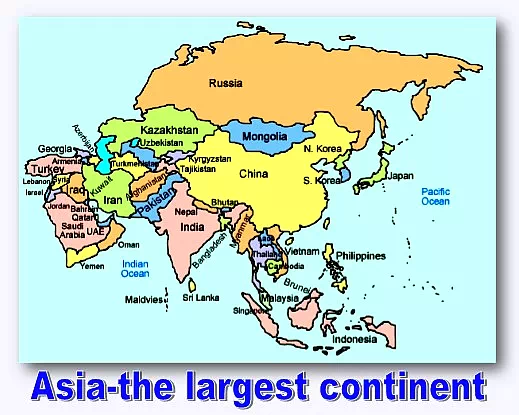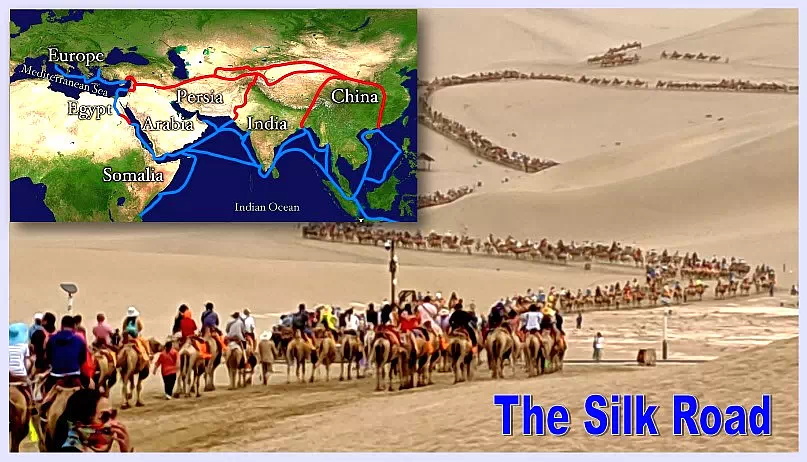Part – 03
1. Which continent has the larger land mass?
- Asia.
- There are 7 continents (1. Europe, 2. Africa, 3. Asia, 4. North America, 5. South America, 6. Australia, and 7. Antarctica.
- Asia is the largest and most populous continent out of all.
- The area it covers is 44,579,000 sq.km (17,212,048 sq. mi).

It has about 4.7 billion people (60% of the world’s population). The estimated human population by November 2021 was 7.9 billion. The boundaries of Asia are:
It has about 4.7 billion people (60% of the world’s population).
The estimated human population by November 2021 was 7.9 billion.
The boundaries of Asia are:
The Pacific Ocean on the east. The Indian Ocean on the south. Arctic Ocean on the north. Border of Europe on the west.
2. What name is given to an animal without a backbone?
- Invertebrate.
Invertebrates are cold-blooded animal with no back bone.
The majority of animal species (about 97%) are invertebrates. Their size varies from
50 µm (0.002 in) to the 9-10 m (30-33 ft.).
The word ‘invertebrate’ is the opposite of the word ‘vertebrate’ which means an animal
having backbone.

They can live on land or in water. Most known invertebrates are arthropods (insects, spiders, centipedes, crabs, etc.), Mollusca or Molluscs (snails, squids and octopuses), Annelid (earthworms, and leeches), Cnidarians (jellyfishes, hydras, and corals, etc.).
3. In Greek mythology, who was the muse of comedy?
- Thalia, the muse of comedy holding a comic mask.

There are nine muses in Greek mythology. They are inspirational goddesses and were considered to represent literature, science, and the arts.
1. Calliope; 2. Clio; 3. Erato; 4. Euterpe; 5. Melpomene; 6. Polyhymnia; 7. Terpsichore; 8. Thalia; 9. Urania.
4. Which is the oldest university in the USA?
- Harvard University.
John Harvard, a puritan clergyman, founded it in 1936 in Cambridge, Massachusetts,
USA.
It is one of the most prestigious universities for higher learning in the world.

The area of its urban campus is 209 acres (85 ha). Its official website is www.harvard.edu. It has 3 main campuses viz. Cambridge campus (in the center), Harvard Yard and the medical campuses (the adjoining campuses) and offers a wide range of disciplines. Its library system contains nearly 80 individual libraries with about 20.4 items. The Shanghai Ranking (The Academic Ranking of World Universities – ARWU) has
ranked the Harvard University as the world’s top university since 2009 (the year it released its first rankings) every year.
5. Which 4,000-mile long trade route connected China with the Mediterranean?
- The Silk Road (Silk Route).
It was the ancient trade route between Asia and Europe that linked China with the west.
The trading activity was at peak between 200 BCE and 1500 CE. This route covered almost 6,400 km (4,000 miles) and played a key role those days in all interactions by connecting the Europe, East

Africa, the Middle East, Central Asia, India, China, the Southeast Asia, and rest of the East. The route got the name, The Silk Road, only because of the main trading of Silk textiles for which China was famous those days.
6. On what date is All Saints’ Day?
- 1, November.
On this day all Christian saints are celebrated in churches.
Many names are ascribed to it such as All Hallows’ Day, the Feast of All Saints, the Feast of All Hallows, the Solemnity of All Saints, and Hallowmas.

It is a feast day in Christianity (Christian solemnity) and has been celebrated since 4th century when a festival was celebrated in honor of all martyrs and saints by the Greek Christians on the first Sunday after Pentecost. Pope Gregory IV announced All Saints Day as an authorized holiday in 835 CE. The liturgical color of this festival is white and the symbols assorted are – 1. A sheaf of wheat, 2. Hand of God, 3. The crown, and 4. The symbols of individual saints. Few countries do not celebrate the festival on November 1. They (mostly eastern churches) celebrate it on the first Sunday after Pentecost.
7. Which sign of the zodiac is represented by a bull?
- Taurus. (The zodiac symbol is Bull). The ruler of this sign is Venus.
It is one of the three earth signs along with Virgo and Capricorn having fixed modalities.
It is the second sign of zodiac in the Northern Hemisphere near Orion; between Aries and Gemini.

The sun is in this sign from about April 20 to May 20. According to astrology, a person who is born while the sun is in Taurus is called born under Bull sign.
It is said that the mythical representation of a Bull came as the Greek god Zeus (the god of sky, the supreme of all gods) had abducted Europa (a princess of Tyre) in the form of a bull to marry her.
There were several ancient cultures established among the Mesopotamians worshipping this sign the first sign of the zodiac calling it ‘The Great Bull of Heaven’ during the early Bronze Age (from about 4000 BCE to 1700 BCE).
8. What is the SI unit of intensity of illumination?
- Lux (Latin word stands for “light” and can be used as both the singular and plural form).
Its symbol is lx. One lux is equal to one lumen per square meter.
It is defined as the amount of illumination provided when one lumen is evenly distributed over an area of one square meter.
Below given are few examples of lux measurement in our daily life:
The illuminance of moonless clear sky is 0.002 lx.

- The illuminance of full moon clear sky is between 0.05– 0.1 lx.
The illuminance of direct sunlight is 32,000-100,000 lx. - Ambient Daylight is 10,000-25,000 lx.
- Overcast Daylight is 1000 lx.
- Sunset & Sunrise is 400 lx.
9. What is the capital of India?
- New Delhi. It is also a Union Territory.
It was established in 1911 by George V during the Delhi Durbar of 1911. British architects Edwin Lutyens and Herbert Baker designed this city.
It was inaugurated by Edward F L Wood (The Lord Irwin), Viceroy and Governor-General, on November 13, 1931

Before that, during the British rule, Calcutta was the capital of India. Several ancient empires of India treated Old Delhi as the political and financial center. The capital hosts the Rashtrapati Bhavan, Parliament House, and the Supreme Court of India.
10. Which country is the world’s largest producer of cheese?
- USA. (Around 6 million metric tons production).
The biggest cheese factory is located in Gooding, Idaho, USA. Germany occupies the second position.
The top producing states of America are – 1. Wisconsin, 2. California, 3. Idaho, 4. New Mexico, and 5. New York, etc.
The first farmstead cheese factory in Wisconsin was opened in 1831.

Nicolas Gerber, a Swiss immigrant, opened first Green County, Wisconsin cheese factory in a small log house in 1868. The next year, he started the first Swiss cheese factory in Wisconsin. By 1899 there were 1500 factories located at rural areas in Wisconsin.
All Blogs & Vlogs from mamlabs.net

